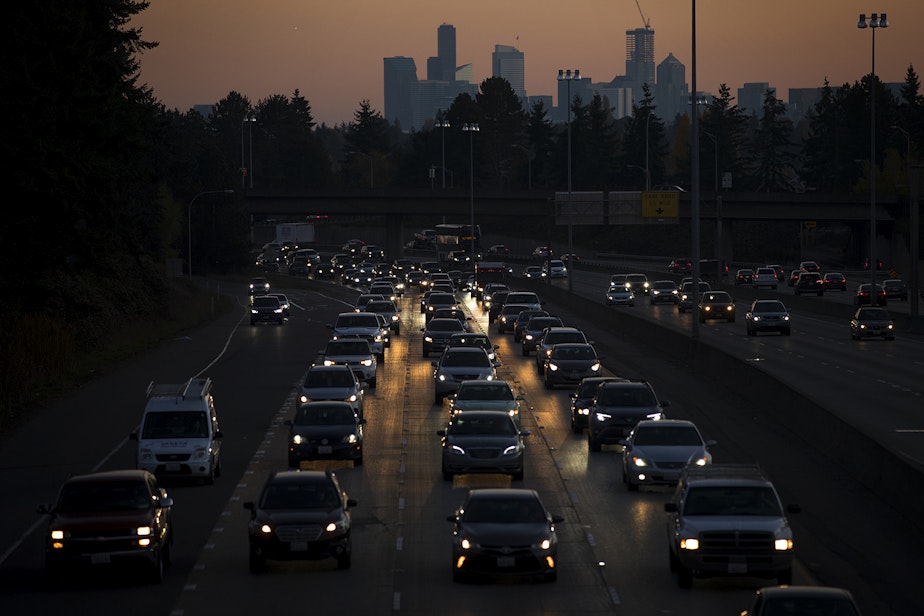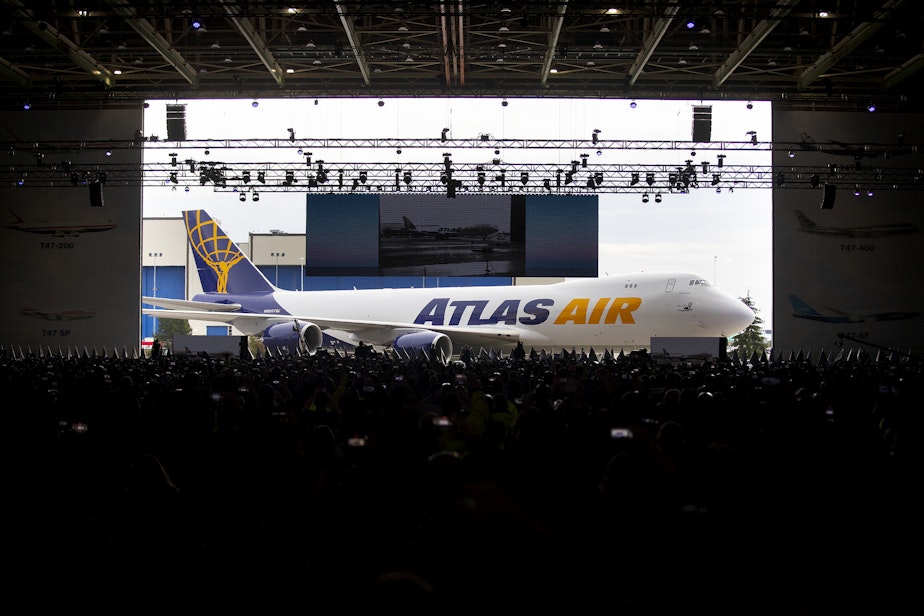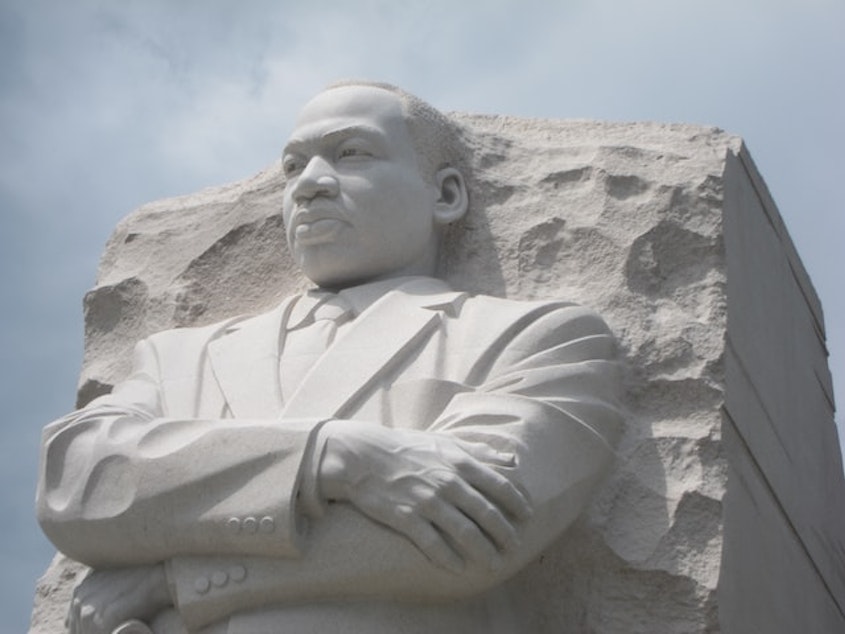Changes down the road for Washington drivers: Today So Far

Washington's roads have become more dangerous over the past couple years. Now, local and national officials are attempting to curb the trend.
This post originally appeared in KUOW's Today So Far newsletter for February 1, 2023.
My apologies to regular TSF readers for my absence yesterday. Without getting into details, I had a special appointment at my dentist which resulted in me feeling pretty groovy. I imagine that if I did try to crank out a newsletter, it would have been far out, man. But the experience did offer an interesting "Did You Know" factoid, which you can read about below.
On a recent morning drive into Seattle, Nina and I watched as two cars sparred across all lanes of traffic. It wasn't clear who made the first offense, but one driver clearly made the other driver mad, and a chase ensued. One car would dart to the far right lane before screeching into the far left lane in an attempt to get away. The other car would catch up and steer into the other, forcing it to sway into yet another lane to avoid a collision. I have no idea who was behind the wheel, but it's safe to assume that critical thinking is not strong with them. This dangerous dance went back-and-forth amid countless other vehicles on I-5. We had a view of this drama from about Federal Way to Tukwila before they sped far ahead and out of view. Nina and I had the same comment at the time: "Things feel a bit more chaotic on the road these days."
Road rage is just one problem among a range of issues plaguing Washington's roads ever since the pandemic first struck. From speeding, to recklessness, to driving under the influence, conditions have grown increasingly dangerous whether on a Seattle street or a state highway. Washington's roadway dangers have now garnered attention from local, state, and federal officials who are aiming money and new laws at our roads. Whether it's your ability to turn right on red, or an increase in protected bike lanes and speed bumps, there are some changes coming down the road.
“There were 745 fatalities on roads in the state of Washington in 2022, the most in more than 30 years,” U.S. Senator Maria Cantwell recently said in a statement. “We must reverse this alarming trend."
Cantwell is targeting millions at Seattle and Washington state roads through her "Safe Streets for All" program. Grant funds are headed to 16 Washington cities and counties. Seattle is getting about $25.7 million, primarily for safety upgrades to roads in SoDo.
Sponsored
"The streets in SoDo are some of the most dangerous streets in the city," Urbanist editor Ryan Packer told Seattle Now this morning. "They have a lot of lanes and the streets are designed for freight traffic ... so people are able to head through that neighborhood extremely quickly, and places to cross are few and far between ... SoDo lacks any real way for people on bikes to travel safely through the neighborhood. It also lacks a lot of pedestrian crossings and places for people to safely navigate on foot."
SoDo's street design creates issues unique to the neighborhood, but the problems on the road span the entire city and the state. Traffic incidents have risen over the past few years.
"Ultimately, the pandemic seems to have produced an environment in a lot of American cities, including Seattle, where pedestrians and people outside of cars are at high risk," Packer said, pointing to high speeds, reckless driving, and driving under the influence as common problems.
From Packer's perspective, Seattle needs to steer away from "decades old line of thinking that prioritizes people getting from A-to-B and not the people who live in between and the people trying to get around who are not in cars." That's means "reallocating the vast amount of space that we have in our city away from cars."
Check out Seattle Now's conversation with Packer here. Also, check out Seattle Now's previous conversation about the dangers surrounding Seattle's Rainier Avenue.
Sponsored
The trending dangers on Washington's roads are also hot topics in Olympia where state lawmakers are currently considering a handful of proposals.
"I personally think our roads are the most unsafe roads we have ever had — to lose 745 people!" State Sen. John Lovick told Northwest News Network. "If there was any other industry where we lost that many people we would do something. We are going to do something."
Lovick is a former state trooper. He is behind a few bills this session, including one that would lower the BAC for DUIs from .08 to .05. He is also proposing an end right turns at red lights across the state.
"People hate change, and they hate the way things are," Lovick said. "I don't say that to get a laugh. That's a change people are going to hate. But they also hate the fact that people are cutting them off, and running them down at intersections."
There is also a proposal to allow traffic cameras, similar to red light or speeding cameras, in highway work zones. Under this proposal, if you speed in a work zone, you could get a speeding ticket in the mail. Check out the suite of traffic safety bills currently under consideration in Washington right now.
Sponsored
AS SEEN ON KUOW

Factory doors opened to display the last Boeing 747 jumbo jet to be produced by the company in front of thousands of guests gathered on Tuesday, January 31, 2023, at Boeing’s factory in Everett. Since it debuted in 1969, the 747 has served as a cargo plane, a commercial aircraft capable of carrying nearly 500 passengers, and the Air Force One presidential aircraft. It revolutionized international travel. Nearly 1,600 747’s were produced by Boeing. Even though the plane will no longer be in production, company officials say they will continue to fly and be supported by the company for decades to come. (Megan Farmer / KUOW)
DID YOU KNOW?
It was my third round of local anesthetic when my dentist asked, "Hmm, well, have you had any caffeine today?" Luckily my answer was "yes," a word I could easily convey without the use of my extremely numb tongue. I consider coffee a major food group, so I had plenty that day, before heading into this dental appointment where local anesthetic wasn't working as well as it should. Sure, I couldn't talk straight, but the rest of my face was sober. My dentist's caffeine question stirred up a memory filed deep in the back of my brain. Years ago, another dentist told me that I should avoid coffee on the day of my appointment. Turns out, there could be an association between the effectiveness of local anesthetic (the shots that make your mouth go numb) and caffeine.
Sponsored
There isn't a lot of readily available scientific evidence that caffeine counters local anesthetics, but it is a phenomenon that dentists are aware of. A study out of Saudi Arabia surveyed patients and dentists and found a few associations, ultimately concluding that something is going on there (my words, not the study's). One thought is that caffeine heightens awareness and anxiety, which in turn, makes for a nervous experience amid needles and drills and poky things. There are also suspicions around pH levels and anesthetic, which could have a coffee angle. There are also thoughts floating around about lactic acid build up with people who often grind their teeth. And side note: Redheads might also have a worse time with anesthetic.
I should also mention that there have been other studies which state coffee could enhance the effects of lidocaine. And there are also dentists out there who say that all the talk over caffeine is overblown and a load of crap. This might be one of those things where it comes down to the person and their specific biology. In any case, just to be safe, it could be a good idea to avoid coffee and tea on the day of your dental appointment.
ALSO ON OUR MINDS

Sponsored
February marks Black History Month, a tradition that got its start in the Jim Crow era and was officially recognized in 1976 as part of the nation's bicentennial celebrations. It aims to honor the contributions that African Americans have made and to recognize their sacrifices.

